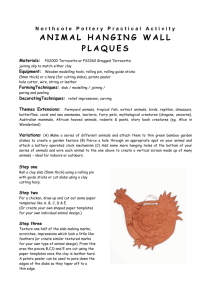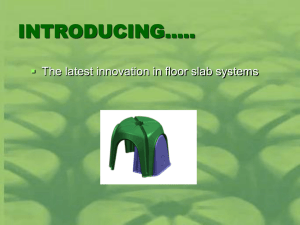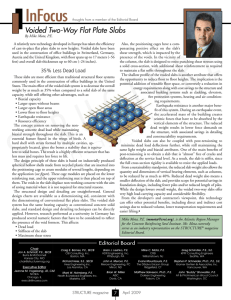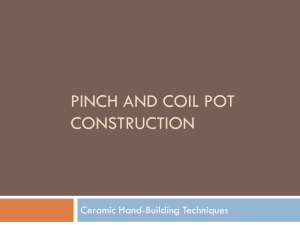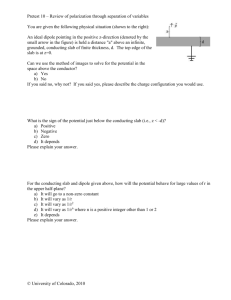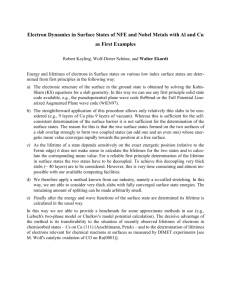Slab Pots
advertisement
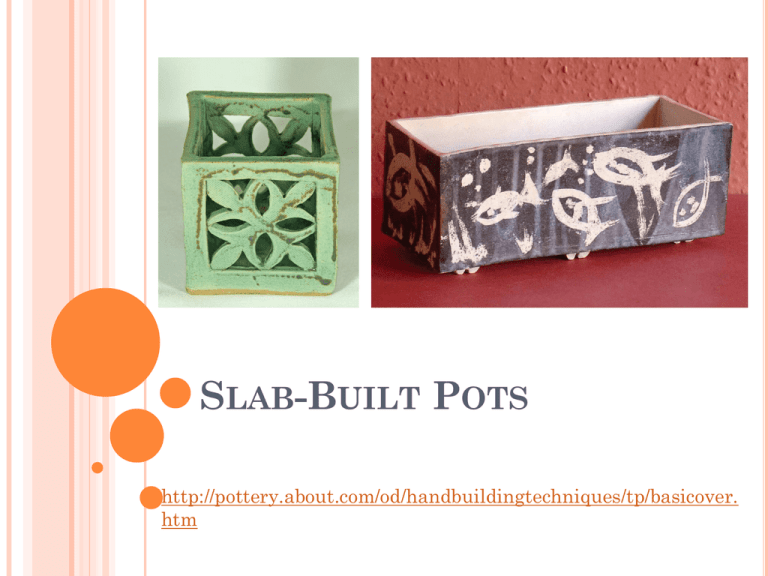
SLAB-BUILT POTS http://pottery.about.com/od/handbuildingtechniques/tp/basicover. htm SLAB-BUILDING, ANCIENT TO MODERN Slab-building techniques were used extensively by Mesoamerican Pre-Columbian potters, with some beautiful results. Other than these potters, though, slab pots were only very minor players in the hand-building playing field of other ancient cultures across the globe. Today, slab pots and slab-building techniques are experiencing a new popularity. Modern potters and ceramic sculptors have embraced the slab, creating works using both soft slabs and stiff leather-hard slabs. SLAB BUILT POTS SLAB BOX ASSIGNMENT MADE SIMPLE http://www.bing.com/videos/search? q=clay+slab+box&view=detail&mid =8371774BB5571DAC91578371774 BB5571DAC9157&first=0 •You will use a ruler to precisely measure your sides •All corners must be square, use score and slip as well as “snake” at seams •Designs can be imprinted before the drying process •Cut out is done before the construction when the clay is leatherhard •Do not use a hairdryer….we will wrap in plastic and wet towel to get to leather-hard state STIFF-SLAB CONSTRUCTION The stiff-slab method is more appropriate for architectural and geometric forms. The slab is rolled then allowed to slowly dry to leatherhard stage before being cut and joined with other stiffened slabs to create the form. Cutting away should occur before construction. Adding feet to a stiff-slab pot is best done after the construction. Use score and slip method. Lids can be made from a complete (six sided) box by using the potter’s needle or using wire. Wax resist the bottom of the box before final firing LEATHER-HARD WORKING SLAB-BUILT BOX QUIZ NAME________________________ 1. Where was slab building used largely in ancient times? A. Egypt B. India C. Mesoamerica D. Target Stores 2. Can the slabs be hand rolled instead of using the slab roller? A. yes B. no C. only on rainy days D. never 3. When can you carve or cut the sides to your box? A. before slabbing when the slab is leather-hard and before construction 4. What is score and slip? A. a new type of pizza glue C. a baseball term B. once the pot is put together C. D. after the bisque fire B. making grooves on wet/leather hard clay and using the slip as a D. none of the above 5. What tool must be used to make the sides equal length? A. ruler B. potter’s tool C. book D. stapler 6. A glaze is: A. applied after the bisque fire B. a chemical C. adds color or protection to a pot D. all of the above 7. How is wax resist used: A. for crayon drawings B. never as a decorative property C. to remove unwanted hair D. keep glaze from the bottom of a pot 8. What is leather hard? A. a Marine term B. point where clay is hard but not dry C. used to make saddles D. last stage in pottery making 9. Cone 06 is the firing level for: A. glazes only B. first fire C. last fire D. never used 10. If you run out of time in class and your pot is not done: A. ask for a pass for PE plastic and damp paper C. Throw the pot away D. give up B. cover the pot with Slab-Built Box Student Evaluation Name______________________________________ Dated ________________ 1. 2. 3. 4. 5. 6. 7. 8. DESIGN 10 9 8 7 6 5 Other CONSTRUCTION 10 9 8 7 6 5 Other CRAFTSMANSHIP 10 9 8 7 6 5 Other PATTERNS/TEXTURES 10 9 8 7 6 5 Other GLAZING 10 9 8 7 6 5 Other One aspect about this project that I learned ___________________________________________ Did you wax resist the bottom of the pots to keep glaze from the shelf? YES NO Was this a project you would consider revising for your final? YES NO
